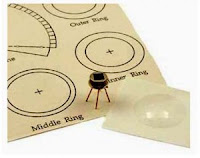DCF77 Preamplifier Circuit Diagram. A popular project among microcontroller aficionados is to build a radio-controlled clock. Tiny receiver boards are available, with a pre-adjusted ferrite antenna, that receive and demodulate the DCF77 time signal broadcast from Mainf lingen in Germany. DCF77 has a range of about 1,000 miles. All the microcontroller need do is decode the signal and output the results on a display. The reception quality achieved by these ready-made boards tends to be proportional to their price.
In areas of marginal reception a higher quality receiver is needed, and a small selective preamplifier stage will usually improve the situation further.
The original ferrite antenna is desoldered from the receiver module and connected to the input of the preamplifier. This input consists of a source follower (T1) which has very little damping effect on the resonant schema. A bipolar transistor (T2) provides a gain of around 5 dB. The output signal is coupled to the antenna input of the DCF77 module via a transformer.


DCF77 Preamplifier Circuit Diagram
The secondary of the transformer, in conjunction with capacitors C4 and C5, forms a resonant schema which must be adjusted so that it is centered on the carrier frequency. An oscilloscope is needed for this adjustment, and a signal generator, set to generate a 77.5 kHz sine wave, is also very useful. This signal is fed, at an amplitude of a few milli-volts, into the antenna input. With the oscilloscope connected across C4 and C5 to monitor the signal on the output resonant schema, trimmer C5 is adjusted until maximum amplitude is observed.
It is essential that the transformer used is suitable for constructing a resonant schema at the carrier frequency. Our proto-type used a FT50-77 core from Amidon on which we made two 57-turn windings. It is also possible to trim the resonant frequency of the schema by using a transformer whose core can be adjusted in and out. In this case, of course, the trimmer capacitor can be dispensed with.












 Relations every time require to bring habitat particular luxurious home entertainment structure. This is for the reason that just very a small number of households can afford home drama system. Of tardy, only the rich and the famous can afford such luxury. This notion is right away a feature of the ancient history. Home plays systems may well now stay vacant to greater numeral of households since of the familiarity of principal home drama design. The basic home theater design may well just require three basic components and these three components might already take place within your means in lieu of the working course group.
Relations every time require to bring habitat particular luxurious home entertainment structure. This is for the reason that just very a small number of households can afford home drama system. Of tardy, only the rich and the famous can afford such luxury. This notion is right away a feature of the ancient history. Home plays systems may well now stay vacant to greater numeral of households since of the familiarity of principal home drama design. The basic home theater design may well just require three basic components and these three components might already take place within your means in lieu of the working course group.